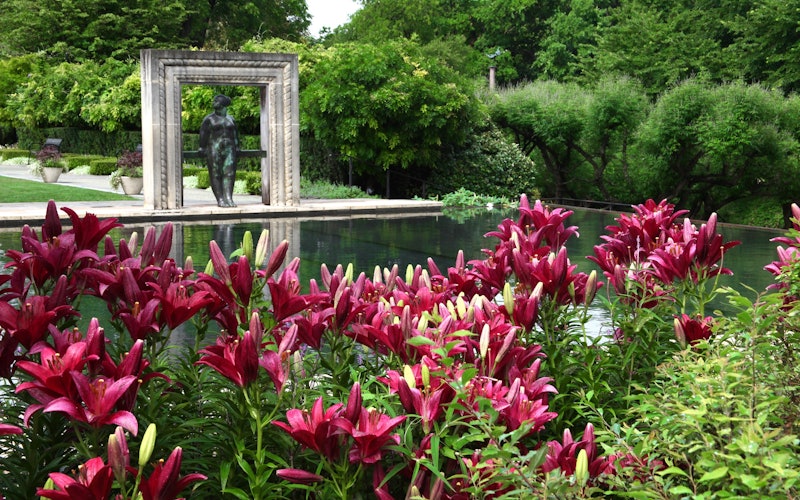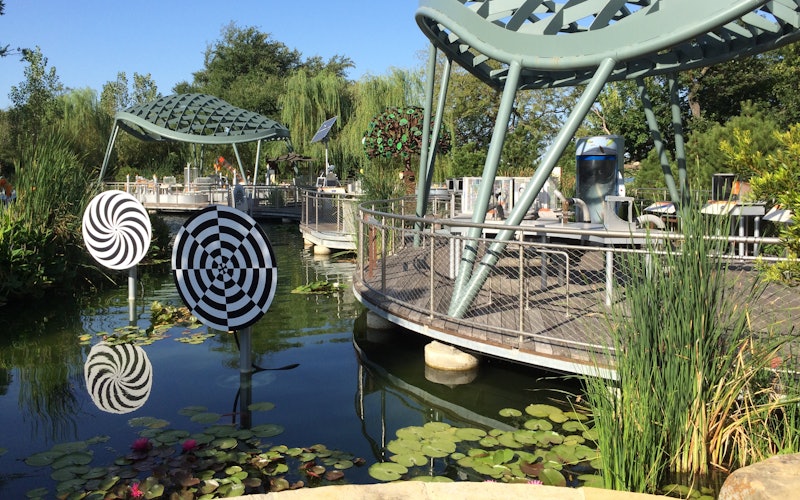
Gardening Resources and Tips
These helpful resources provide information for those interested in creating a beautiful and thriving garden in North Texas. Check back each season for up-to-date information.
Education and research are at the core of the Dallas Arboretum and Botanical Garden’s mission. Here you will find information about what’s in bloom this season, tips and tricks for creating a successful garden, and a list of local clubs dedicated to a variety of horticultural interests.
Video Resources

Plant Features and Tips
Our Plant Features and Tips series highlights a variety of plants, both from our seasonal color and our permanent collection, with plant needs, growing tips and interesting facts.

Garden Tours
In this video series, Dave Forehand, VP of gardens, takes you on narrated tours to show you the highlights and features of some of the most beautiful gardens at the Arboretum.

Education
We have a number of educational videos for children featuring fun activities and labs!

North Texas Cactus and Succulent Society
The North Texas Cactus and Succulent Society (NTCSS) is a community for cactus and succulent enthusiasts in the Dallas area, founded in 1974 to promote interest in and knowledge of these plants. The society holds monthly meetings on the first Tuesday of each month at the Dallas Arboretum, featuring plant-related programs, show-and-tell sessions, and guest speakers. Membership is $10 per year, and visitors are welcome. More details can be found on their website or Facebook page.
Tips and Tricks by Month
Need help planting a successful garden? These tips and tricks from our horticulture staff can help keep your home garden looking beautiful this fall.
In North Texas we ask a lot of our plants. With extreme temperatures in the summer and periods of too much or no rain at all, it’s important to equip your garden accordingly. Take a look at these suggestions designed to help your home garden thrive.

January
- Plant/Relocate trees and shrubs now while they are dormant so roots can establish. Prune trees and shrubs to remove unwanted or unhealthy growth in order to maintain an attractive growth habit.
- Plant annual color in beds and containers during days with warmer temperatures. Fertilize annuals regularly with a complete, water soluble fertilizer.
- Divide and replant summer and fall blooming perennials while they are still dormant.
- Spring blooming bulbs can still be planted until mid January in order to give them enough time to establish roots and bloom.
- Plan your early spring vegetable garden. Sow seeds for spring annuals and veggies, inside, per instructions based on the last frost date for your area. They need full sun and temperatures around 65 to 70 degrees (watch out for cold window sills!).
- Rye and Fescue seed can be spread during extended periods of warm temperatures. Fertilize overseeded lawns once they are established.
- Mulch new plantings to help retain moisture and insulate roots against cold temperatures.
- Keep frost cloth handy to cover any tender annuals, perennials or new plantings since January is usually the coldest month in North Texas.
March
- Plant cool season annuals for quick color in the garden and to replace any annuals that may not have made it through the cold.
- Some warm season veggies, such as tomatoes, can be planted late in March, but be prepared to cover them if we have freeze or frost.
- You may still have some time to dig and divide fall blooming perennials if they haven’t started putting out new growth yet.
- It’s a great time to plant new trees and shrubs in the garden so they establish a good root system before summer. Make sure to fertilize them so they get a good start.
- Begin thinking about sodding or seeding your lawn, late in March, once the last frost date has passed. Mow your lawn shorter than normal to help remove early weeds before seeding. Grass is an easy to maintain groundcover that helps retain soil moisture and helps reduce soil erosion. Don’t forget to start fertilizing your lawn as well.
- Prune and shape any spring flowering shrubs and vines as soon as they finish blooming.
- Once trees and shrubs begin to green up, trim any dead or damaged areas that become obvious.
- Continue Fertilizing winter and spring annuals.
May
- Plant your heat tolerant summer annuals and tropicals, if you haven’t already. Our favorites for the heat are Lantana, Ornamental Sweet Potato Vine, Purple Fountain Grass, Ornamental Peppers, Coleus, Elephant Ears, Caladiums, Pentas, and Tropical Hibiscus.
- Continue planting perennials, trees and shrubs. Just be sure to water them in well as the temperature rises and continue watering them regularly, making sure to saturate the root ball on trees and shrubs as much as twice per week, throughout the summer.
- The last of the heat tolerant veggies and annual herbs can be planted until mid month, including Southern Peas, Sweet Potatoes, Basil and Oregano.
- Fertilize your lawn and garden with a high nitrogen fertilizer, following recommended application rates.
- Be sure to water grass regularly during the hot summer months, up to one inch depth, 2 to 3 times weekly, or what your city water restrictions will allow.
- Mow your lawn once per week to maintain good healthy growth and reduce any unnecessary wear and tear on lawn equipment.
- Continue pruning and reshaping any spring blooming shrubs and vines after they finish flowering.
July
- July is the month to start your fall tomato garden.
- Begin trimming spent flower stalks on perennials.
- If you haven’t done so already, cut back some overgrown annuals (such as impatiens and coleus) and perennials (such as asters and salvia). A light shearing can help prevent the plants from falling over.
- Roses can be trimmed back now by one-third to one-half so they will rejuvenate for the fall season.
- Mature or overgrown climbing roses can be shaped up now without damaging next year’s bloom potential.
- As it continues to heat up outside, keep your plants well watered.
- Continue mowing your lawn once per week to maintain good healthy growth and reduce any unnecessary wear and tear on lawn equipment.
- Continue fertilizing your lawn and garden with a high nitrogen fertilizer, following recommended application rates.
September
- Plant annual color, such as mums, marigolds, and ornamental peppers, to add seasonal interest to the autumn garden.
- Deadhead spent rose flowers to keep shrubs blooming throughout the season. Now is the time to plant new rose shrubs.
- In the vegetable garden, plant cool season veggies, such as carrots, cauliflower, broccoli, cabbage, lettuce, and mustards, to be harvested through the fall and winter months.
- Start planting trees, shrubs, and perennials as cooler autumn temperatures will help plants establish roots before winter.
November
- Continue planting trees and shrubs now while they are becoming dormant so they can establish roots during winter. An application of root stimulator will help get them started.
- Transplant trees and shrubs in your landscape now. Give them a large enough root ball when transplanting to avoid root damage.
- Dig and divide spring blooming perennials now so their roots can get established before spring.
- Prune back fall-blooming perennials to produce healthy, bushy plants next spring.
- Plant narcissus and pre-chilled tulips toward the end of the month.
- Plant pansies, dianthus, kale and other winter annuals, as well as cool season veggies such as broccoli and cabbage.
- Fertilize annual color with a complete, water soluble fertilizer.
- Mulch new plantings to help retain moisture and insulate roots against cold temperatures.
February
- Plant winter annuals such as pansies, dianthus, snapdragons and chard on warmer days.
- Sow seeds for spring annuals and veggies, inside, per instructions based on the last frost date for your area. Remember they need full sun and temperatures around 65 to 70 degrees (watch out for cold window sills!).
- Divide and replant summer and fall blooming perennials while they are still dormant.
- Plant or relocate native and cold hardy trees and shrubs while they are dormant. It is also the perfect time to perform any tree trimming.
- Start pruning roses. A good rule of thumb is to prune them by Valentine’s Day. Climbing roses won’t need any trimming until after they bloom in spring.
- Mulch flower beds before the weather warms up and weeds begin to sprout.
- Fertilize winter annuals throughout the winter and continue into spring. Use a complete, water soluble fertilizer to help them get established while it’s still cold.
April
- Begin planting summer annuals, such as lantana and pentas (sun) and begonias and coleus (shade), as they become available at local nurseries. Some summer tropicals may also be found in nurseries toward the end of April
- Now is great time to plant new perennials in your garden. Make sure to select plants that are right for your zone. Consult nursery professionals if you are uncertain.
- Continue planting new trees and shrubs. Don’t forget to fertilize new plantings.
- All summer veggies and herbs can be planted this month.
- Continue sodding and seeding lawns. As the temperatures warm, make sure sod stays moist until it begins to root out.
- Continue any tree and shrub pruning to reshape old and new growth.
- Continue pruning and reshaping any spring blooming shrubs and vines after they finish flowering.
- Continue fertilizing lawns and prepare to start mowing if you haven’t already.
June
- Plant summer annuals and tropicals. Don’t forget to water them in after planting and keep them watered regularly during the summer heat.
- Begin cutting back any overgrown perennials and annuals to keep growth compact.
- Continue mowing your lawn once per week to maintain good healthy growth and reduce any unnecessary wear and tear on lawn equipment.
- Continue fertilizing your lawn and garden with a high nitrogen fertilizer, following recommended application rates.
August
- Proper watering is crucial in August. Apply one to two inches of water per week to -landscaping.
- Keep an eye out for webworms in trees. Use a garden hose to blast them out of the trees with water or cut them out with pole pruners.
- Plant vegetable crops, including corn, tomatoes, and beans, for fall harvest.
- Plant seasonal annuals such as marigolds and ornamental peppers for fall interest.
October
- Start planning your purchase of pre-chilled, spring-blooming bulbs, like tulips, daffodils, and hyacinths.
- Start planting cool season annuals, such as pansies, ornamental kale, and snapdragons.
- Plant herbs like cilantro and parsley now for harvesting through the fall and winter months.
- Keep newly planted trees, shrubs, perennials, and seasonal color watered to help them establish.
For help identifying plants and other horticultural questions, please contact the Texas A&M Agrilife Extension Dallas County Master Gardeners. Dallas County Master Gardeners provide free gardening advice to area residents, and welcome the opportunity to help you find the solution to your gardening problems. Just call 214.904.3053. The Help Desk is available Monday – Friday, 9:30am – 3:30pm. If you prefer to send an email, or wish to include a photo, please click here.